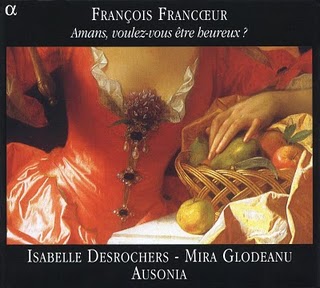Sonate en mi mineur pour violon et basse continue (IIe Livre)
Fureur, Amour, secondés mon impatience (Scanderberg)
Sonate en la majeur pour violon et basse continue (IIe Livre)
L’Amour fait naître nos désirs (Pirame et Thisbé)
Loin de nos cœurs les tristes plaintes (Scanderberg)
Vole de victoire en victoire
Splendete, luci belle (Scanderberg)
Sonate en ré mineur pour violon et basse continue (IIe Livre)
Que dans ce séjour, nos transports paroissent (Tarsis et Zélie)
Lance tes traits, Amour (Pirame et Thisbé)
D’un tendre Amour, ne craignez rien (Pirame et Thisbé)
Amans, voulez-vous être heureux?
Isabelle Desrochers - soprano
Ensemble Ausonia
Mira Glodeanu - violon
Nils Wieboldt - violoncelle
James Munro - violone et contrebasse
Julian Behr - théorbe
Frédérick Haas - clavecin & direction
http://disinfestavaxhome.blogspot.com/2011/02/francois-francoeur-amans-voulez-vous.htmlThe son of a double bass-player in the 24 Violons du Roi, François Francoeur was born on September 21, 1698. His prodigious early talent as a violinist gained him a place in the Opéra orchestra at the age of either 12 (New Grove Opera) or 15 (the notes for the present disc), where he was joined by the equally youthful François Rebel, the son of the more famous Jean-Ferry Rebel. The two youngsters formed what was destined to be a lifetime of collaboration, being known throughout their lifetime as “les petits violons.”
In 1720, Francoeur published the first of two sets of violin sonatas, the second, engraved by Leclair’s wife, appearing 10 years later. His main interest, however, was in opera, the earliest of which were three tragédies en musique: Pirame et Thisbé (1726), Tarsis et Zélie (1728), and Scanderberg (1735), all written in close partnership with Rebel. So close, in fact, that in his famous Essai sur la musique ancienne et moderne . . . (1780), de La Borde recalled that when one was asked which had composed a particular piece, he would reply, “That number is by us both.” Later, their joint efforts extended to other positions at the Opéra, including that of music director, and culminating in their appointment in 1757 as joint administrative directors, ushering in a period during which the Opéra was “managed . . . better than it had ever been managed.” In addition to their activities at the Opéra, both Francoeur and Rebel gained a number of court posts, including membership of the 24 Violons, and responsibility for staged opera at Versailles when it resumed in 1745 after a break of several decades. Francoeur died in Paris on August 5, 1787, 12 years after his life-long associate.
The present disc, so far as I’m aware the first to be wholly devoted to Francoeur (or perhaps we should say Francoeur and François Rebel), brings us a cross section of his works that includes three of the violin sonatas from the second Livre (1730), interspersed between which there come a selection of airs from the three tragédies en musique. While eschewing the more overt virtuosity of Leclair, Francoeur gives the violinist plenty to think about in the sonatas, with passages of double and triple stopping and wide leaps. With the exception of two finales marked Gay (A-Major/iv and D-Minor/vi) that have a marked Italian brilliance and drive, French elegance and finesse are predominant. Finest of all these works is probably the four-movement E-Minor Sonata, which opens with a cantabile, song-like Adagio, its calm exterior tinged with hints of melancholy. Then comes an energetic Courante, with effective imitative exchanges between violin and continuo, a tombeau-like Sarabande whose hesitant progress is perhaps too emphasized in the present performance, and an elegant Rameauesque Rondeau finale. The performances are very good, if not the last word in technical accomplishment. Violinist Mira Glodeanu is the possessor of fine, rich tone; there is nothing effete about her playing, but her intonation is not all it might be, and she’s prone to produce unattractive sounding passages of double-stopping. The continuo support is positive, but Ausonia is one of an apparently growing number of ensembles that employs a 16-ft. bass in Baroque chamber music, a procedure that has no historical foundation.
The mostly brief airs are extremely appealing, suggesting that the Francoeur/Rebel operas would certainly be worth further exploration. In general, they are light, captivating pieces, several being ariettes (the French equivalent of the da capo aria), but the most substantial, “Fureur, Amour” from Scanderberg, is a highly dramatic outpouring of fury reminiscent of some of the music Rameau wrote for Hippolyte et Aricie, premiered at the Opéra two years earlier. It is given a suitably impassioned performance by Isabelle Desrochers, who is elsewhere required to be little other than charming or agile-voiced, both of which she manages to be with ease. This comes in Alpha’s “ut pictura musica” series, and I cannot resist mentioning the utterly enchanting featured painting, Vertumne et Pomona, by Jean Ranc (1674–1735), an artist previously unknown to me. As usual, Denis Grenier discusses it with authority, making for an added bonus to an excellently engineered disc well worth the attention of anyone with an interest in French Baroque repertoire.
FANFARE: Brian Robins

No hay comentarios:
Publicar un comentario